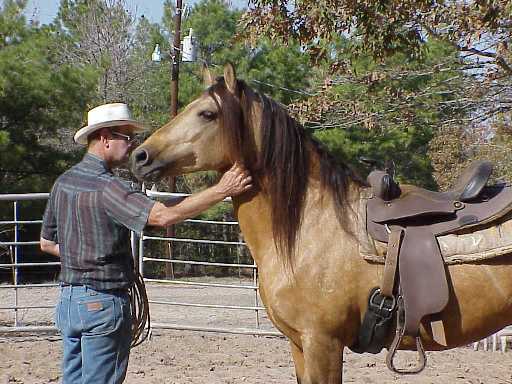|
Had we
had a proper trainer when we had all our other 'mistake' horses,
I feel sure we'd have stayed in horse ownership rather than buying
and selling 'junk' mounts. I can't emphasize enough the value
of a good school for both yourself and your horse. Just casual
observation of the Paso De Fe
methods has taught both John and myself a tremendous amount.
Most horses
who need 'retrofitting' just need to be reminded what their job
is. Often, the owner has allowed them to develop bad habits, or
allowed the horse to have his way when a conflict of interest
arises. You probably could reschool your own horse, but knowing
that it was yourself who developed the lax habits or bought a
horse with problems, it's usually more efficient if a qualified
horse trainer reschools your horse for a few lessons. If you heed
their advice and continue the good riding habits, it's money well
spent! I realize now, our little mustang mare could have been
'salvaged' if we'd had the Ledbetters involved in her training.
As it was, she was terrified of men in general, leery of anything
that looked like a rope, and was primarily a 'pasture ornament'
while she was here. I think we paid $300 for her, and with another
$500 - $1000 in training, we could have had a great pleasure mare.
Because of our inability to cope with her, she was resold, probably
passing from hand to hand, with no one really getting full use
out of her. Unfortunately, most of the auction horses end up going
this route before they're finally meated out for dog food. But
it doesn't have to be that way! If you want an animal to ride
companionably and confidently, they often need to be on a 'continuing
education program'.
Basically,
an overview of the Cathy & Richard Ledbetter Method is to
start
with round penning a horse. Getting to know their personalities,
quirks, finding out what they already know, and gaining their
confidence is key in this teaching method. Usually beginning with
a turn-out alone to let the animal work off any nervousness, and
just to quietly stand by, watching their action.

In the photo
here, Retador, a young Paso Fino stallion is under saddle, but
still has a lot of pent-up energy to unleash. By allowing him
some time alone to warm up, he's more focused when the actual
riding begins.
Moving
into the arena with the horse, getting it to walk up, trot (or
gait) out, turn to the opposite direction, and stopping on command
is the next step. A horse that stops and faces the trainer, will
go to the next lesson, maybe that session, maybe after a small
treat or rewarding pat. A horse that sulls up and stops in a mad
snit, heels toward the trainer gets to go again and again until
he/she figures out that this is their fate until they pay respect
and attention to the human in the ring with them. Most commands
are practically silent, body language only. When both horse and
human are totally focused on each other in the ring, it's an awesome
exhibition.

Here,
Richard has entered the arena, and is 'asking' Retador for cooperation.
The stallion is ready to work after his warm up lopes around the
round pen, and is eager to please. Note, no headgear, this is
all free will on Retador's part!
I realize
I make all this sound simple. Something anyone could do, but it
takes years of 'reading' horses, knowing what every move, twitch,
and gesture on both trainer and horse's part means to the other.
Text
and images copyright 2000 Martha
Wells
|